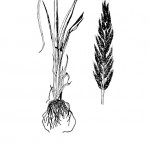Barnyardgrass , Large Barnyardgrass
Echinochloa crus-galli var. crus-galli
Poaceae
Description
Stout stems grow from a somewhat decumbent base. Leaf sheaths are glabrous and smooth with long, flat blades. The 2 to 5 inch or 5.08 to 12.7 cm long panicle is usually erect but can be nodding, is green or purple in color, and is densely branched. Leaves have a unique light-colored mid-vein. Barnyardgrass does not have ligules (i.e., thin outgrowths between the leaf and stalk). Blade sheaths closest to the ground often appear reddish in color. Racemes usually spread with maturity. The spikelets may have long awns, are pale green to dull purple, and are densely arranged on branches; each floret is covered with short spines. Fertile lemma (i.e., bracts enclosing a floret) are pale yellow, ovate to elliptic in shape, smooth, and 3 to 3.5 mm in length. It is self-pollinating and a prolific seed producer. A healthy Barnyardgrass specimen can produce from 750,000 to one million seeds. Barnyardgrass is an annual, warm-season, introduced species, reaching 12 to 48 inches or 0.3 to 1.2 meters tall. Fair to poor grazing for livestock or wildlife, though the seeds furnish food for some ground birds and provide important habitat for waterfowl and pheasant in the playa lakes of Texas and New Mexico.Habitat
Grows mostly as a weed in moist, poorly drained, and disturbed areas. Native to the Eastern hemisphere. Barnyardgrass is widespread in fields, waste areas, ditches, marshes, wet meadows, floodplains, and riparian areas. It is mostly found in disturbed locations with non-saline soils.Images
Plant Characteristics
Seed Type: Non-Encapsulated
Duration: Annual
Stem Texture: Hairless/Smooth
Growth Habit: Bunch grass, Grasses
Leaf Shape
 : Simple with Pinnate or Parallel Venation
: Simple with Pinnate or Parallel Venation
Season: Warm
Distribution
 : 01 - Pineywoods, 02 - Gulf Prairies and Marshes, 03 - Post Oak Savannah, 04 - Blackland Prairies, 05 - Cross Timbers and Prairies, 06 - South Texas Plains, 07 - Edwards Plateau, 08 - Rolling Plains, 09 - High Plains, 10 - Trans-Pecos
: 01 - Pineywoods, 02 - Gulf Prairies and Marshes, 03 - Post Oak Savannah, 04 - Blackland Prairies, 05 - Cross Timbers and Prairies, 06 - South Texas Plains, 07 - Edwards Plateau, 08 - Rolling Plains, 09 - High Plains, 10 - Trans-Pecos
Distributions
Distribution refers to the ecological region in Texas that a plant has been found. You can also view a clickable map.
Book: Know Your Grasses (B-182)
Collection: Grasses


